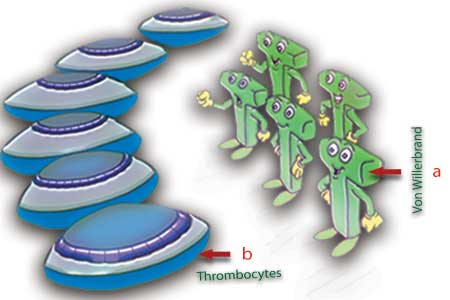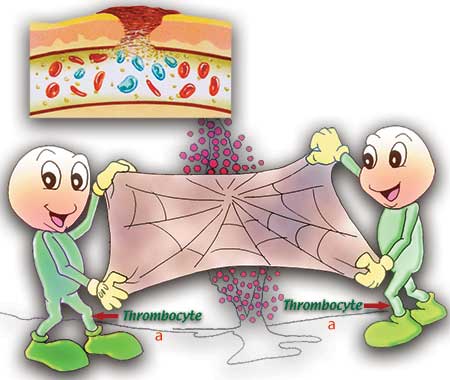When you cut yourself, or when an old wound starts bleeding again, you know that the bleeding will eventually stop. Over the area concerned, a scab will form that will gradually harden, and under it, the wound will heal itself.
This may seem to you to be quite a simple matter. The fact is, however, that biochemists’ research has revealed that this is the result of a highly complex system.26The absence or impairment of any of the components of this system will mean it fails to function at all.
The blood must clot in the right location and at the right time, and it must cease when local conditions return to normal. The system must function flawlessly, right down to the very smallest detail.
 |
| a. von Willebrand |
| Figure 115: A protein known as the von Willebrand factor prevents the thrombocytes traveling through the bloodstream from bypassing the site of the injury. |
In the event of bleeding, clotting must take place at once if the organism concerned is not to die from loss of blood.
Furthermore, clotting must take place along the extent of the injury and, most importantly, must be limited to only the site of that injury. Otherwise, more blood clotting will result in the death of the organism. For that reason, blood clotting must be kept under tight supervision; the scab must form in the right place at the right time.
Blood platelets—or thrombocytes, the smallest of the bone-marrow cells—have one vitally important characteristic. These cells are the main element in blood clotting. A protein known as the Von Willebrand factor ensures that the thrombocytes traveling through the bloodstream do not bypass the site of any injury. The thrombocytes caught here release a substance that brings other thrombocytes to the same site. Together, these cells then close up the open wound.
Once they have discharged their duties, the thrombocytes die. Their self-sacrifice is just one part of the blood-clotting system (Figure 115).
Another protein responsible for blood clotting is thrombin, a substance produced only where there is an open wound. This production must be neither to great nor too small. In addition, it must take place and cease at exactly the right time. To date, more than 20 bodily chemicals that play a role in thrombin production have been described, and all are enzymes. These enzymes can halt or initiate their own production. The process is so tightly controlled that thrombin forms only in the event of tissue injury. As soon as all the enzymes required for clotting reach the requisite levels in the body, structural substances—long fibers which are actually proteins, known as fibrinogen —are formed. In a short time, a whole network of fibrinogen fibers is established where the blood is flowing to the outside. The thrombocytes in the blood become caught in this network and accumulate in it.
As this accumulation thickens, it will halt the flow of blood by acting as a stopper. What we refer to as a scab is the stopper that forms in this way (Figure 116).
The blood clot is absorbed when the wound is fully healed.
The system that ensures the formation of a clot, that determines the extent of that clot, and that strengthens or eliminates it is of irreducible complexity. Blood clotting is a chain of events in which one event sets another in motion.
 |
| a. Thrombocyte |
| Figure 116: Thrombocytes set up a network consisting of fibrinogen threads. Other become caught up in the web and accumulate, thus halting the bleeding by acting as a patch or a stopper. |
The system functions flawlessly, right down to the tiniest detail.
What would happen in the event of the slightest impairment to that system? What, for instance, would occur if clotting took place in the absence of any wound? Or if the clot that formed were easy to detach from the injury? In that event, the arteries leading to such vital organs as the heart, lungs and brain would become clogged up with clotting materials, and this would inevitably result in death.
This fact shows us once again that the human body has been perfectly created. It is impossible for even the blood-clotting system to be explained in terms of coincidences and gradual development, as the theory of evolution would maintain. This system, every detail of which is the product of a separate blueprint and calculation, reveals the perfection of creation. Almighty God, Who created us and placed us on this Earth, has created our bodies with this system that protects against wounds both great and small.
In addition, blood clotting is highly important not just for those external wounds visible to the naked eye, but also for repairing damage that takes place every day in our capillary vessels. Although you seldom feel them, you actually suffer tiny hemorrhages during the whole course of the day. When you bump your arm against a door or sit down too hard, hundreds of tiny capillary blood vessels are broken. But the internal bleeding that occurs as a result of this is immediately stopped, thanks to the clotting system, and the body subsequently rebuilds its capillary vessels. If the blow concerned is quite hard, the internal bleeding before clotting occurs will be quite powerful also, for which reason bruising occurs at the site. Anyone born without this clotting system in the blood is known medically as a hemophiliac and must be protected against the slightest knock for his whole life, and even wrapped in cotton wool. However, patients with severe hemophilia do not tend to live long. Even internal bleeding caused by a fall in the street can swiftly prove fatal.
In the face of these facts, all human beings must reflect on the miracle of creation of their own bodies and give thanks to God, Who created it so perfectly. This body, of which we are unable to produce a single system, or even a single cell, is a blessing bestowed on us by Almighty God.
In the Qur’an our Lord states:
We created you, so why do you not confirm the truth? (Surat al-Waqi‘a, 57)
There are certainly Signs in the earth for people with certainty; and in yourselves as well. Do you not then see? (Surah Adh-Dhariyat, 20-21)